Distribution Patterns and Main Controlling Factors of Helium in the Ordos Basin
Abstract
1. Introduction
1.1. Research Status
1.2. Innovation Points
2. Geological Overview of the Ordos Basin
3. Samples and Methods
4. Results
5. Discussion
5.1. Origin of Helium in the Ordos Basin
5.2. Main Controlling Factors of Helium Accumulation in the Ordos Basin
6. Conclusions
- (1)
- The helium content in natural gas from the Ordos Basin ranged from 0.029 to 0.233% by volume on average, exhibiting a distribution pattern of enrichment at the margins and depletion in the central region. The primary helium source was the radioactive decay of elements within basement metamorphic–magmatic rocks. Notably, higher helium contents were observed in the Qingyang Paleo-Uplift and Yimeng Uplift areas.
- (2)
- The Ordos Basin featured well-developed basement faults, which served as effective migration pathways for helium. Helium migrated along these basement faults after generation, which resulted in significantly higher helium contents along fault zones compared to the surrounding areas.
- (3)
- A model was established for helium accumulation in the Ordos Basin, incorporating basement generation, fault migration, and caprock sealing. The overall distribution of helium was controlled by the distribution of basement helium source rocks, while local enrichment was influenced by basement fault systems.
Author Contributions
Funding
Institutional Review Board Statement
Informed Consent Statement
Data Availability Statement
Conflicts of Interest
References
- Wang, D.; Li, J.; Yu, Z.; Zhang, J.; Liu, L.; Xiao, F.; Shan, C. The Resource Potential and Development Prospect of Helium in Changqing Gas Field. Geofluids 2022, 2022, 9094667. [Google Scholar] [CrossRef]
- Brown, A. Origin of helium and nitrogen in the Panhandle–Hugoton field of Texas, Oklahoma, and Kansas, United States. AAPG Bull. 2019, 103, 369–403. [Google Scholar] [CrossRef]
- Brown, A. Formation of High Helium Gases: A Guide for Explorationists. In Proceedings of the AAPG Convention, New Orleans, LA, USA, 11–14 April 2010. [Google Scholar]
- Li, Y. Accumulation Conditions and Resource Prospects of Helium in the Weihe Basin; Geological Publishing House: Beijing, China, 2022. [Google Scholar]
- Anderson, S.T. Economics, Helium, and the U.S. Federal Helium Reserve: Summary and Outlook. Nat. Resour. Res. 2018, 27, 455–477. [Google Scholar] [CrossRef]
- Ballentine, C.J.; Burnard, P.G. Production, Release and Transport of Noble Gases in the Continental Crust. Rev. Mineral. Geochem. 2002, 47, 481–538. [Google Scholar] [CrossRef]
- Lucas, J.R.; Batenburg, S.J.; Hillegonds, D.J.; Mabry, J.C.; Jenkyns, H.C.; Ballentine, C.J.; Robinson, S.A. Helium-isotope constraints on palaeoceanographic change and sedimentation rates during precession cycles (Cenomanian Scaglia Bianca Formation, central Italy). Sedimentology 2024, 71, 1895–1921. [Google Scholar] [CrossRef]
- Oxburgh, E.R.; O’Nions, R.K.; Hill, R.I. Helium isotopes in sedimentary basins. Nature 1986, 324, 632–635. [Google Scholar] [CrossRef]
- Kennedy, B.M.; van Soest, M.C. Flow of Mantle Fluids Through the Ductile Lower Crust: Helium Isotope Trends. Science 2007, 318, 1433–1436. [Google Scholar] [CrossRef] [PubMed]
- Ballentine, C.J.; Sherwood Lollar, B. Regional groundwater focusing of nitrogen and noble gases into the Hugoton-Panhandle giant gas field, USA. Geochim. Cosmochim. Acta 2002, 66, 2483–2497. [Google Scholar] [CrossRef]
- Liu, Y. Geochemistry of the Elements; Science Press: Beijing, China, 1984. [Google Scholar]
- Franz, J.D. Uranium Ore Deposits; Springer: Berlin/Heidelberg, Germany, 1993. [Google Scholar]
- Wang, X.; Liu, Q.; Liu, W.; Li, X.; Tao, C.; Li, X.; Zhao, D.; Zhang, J.; Zhu, D.; Meng, Q. Helium accumulation in natural gas systems in Chinese sedimentary basins. Mar. Pet. Geol. 2023, 150, 106155. [Google Scholar] [CrossRef]
- Landais, P. Organic geochemistry of sedimentary uranium ore deposits. Ore Geol. Rev. 1996, 11, 33–51. [Google Scholar] [CrossRef]
- Syed, H.S. Comparison studies adsorption of thorium and uranium on pure clay minerals and local Malaysian soil sediments. J. Radioanal. Nucl. Chem. 1999, 241, 11–14. [Google Scholar] [CrossRef]
- Wang, D.; Nie, J.; Lin, J.; Pang, Y.; Wang, Z.; Qin, K. Geochemical Properties and Mineralization Processes of Uranium. Tecton. Miner. 2022, 46, 282–302. [Google Scholar]
- Tedesco, S.A. Geology and Production of Helium and Associated Gases; Elsevier: Amsterdam, The Netherlands, 2022. [Google Scholar]
- Gilfillan, S.M.V.; Ballentine, C.J.; Holland, G. The noble gas geochemistry of natural CO2 gas reservoirs from the Colorado Plateau and Rocky Mountain provinces, USA. Geochim. Cosmochim. Acta 2008, 72, 1174–1198. [Google Scholar] [CrossRef]
- Zhang, C.; Gong, M.; Tian, W.; He, Y.; Zhu, D.; Wang, L. Evaluation of Helium Resources and Accumulation Model in the Yakela Area, Tarim Basin. Nat. Gas Geosci. 2023, 34, 1993–2008. [Google Scholar]
- Liu, K.; Chen, J.; Fu, R.; Wang, H.; Luo, B.; Dai, X.; Yang, J. Discussion on the Distribution Patterns and Controlling Factors of Helium-Rich Natural Gas in the Weiyuan Gas Field. J. China Univ. Pet. (Nat. Sci. Ed.) 2022, 46, 12–21. [Google Scholar]
- Chen, X.; Chen, G.; Bian, R.; Du, W. Helium Resource Potential and Genesis Mechanism in the Fuling Shale Gas Field, Sichuan Basin. Nat. Gas Geosci. 2023, 34, 469–476. [Google Scholar]
- Qin, S.; Dou, L.; Tao, G.; Li, J.; Qi, W.; Li, X.; Guo, B.; Zhao, Z.; Wang, J. Helium Enrichment Theory and Exploration Ideas for Helium-Rich Reservoirs. Pet. Explor. Dev. 2024, 51, 1340–1356. [Google Scholar] [CrossRef]
- Hassanpouryouzband, A.; Armitage, T.; Cowen, T.; Thaysen, E.M.; MCMahon, S.; Hajibeygi, H.; Stevenson, D.S.; Stahl, M.; Haszeldine, R.S. The Search for Natural Hydrogen: A Hidden Energy Giant or an Elusive Dream? ACS Energy Lett. 2025, 10, 3887–3891. [Google Scholar] [CrossRef]
- Hassanpouryouzband, A.; Wilkinson, M.; Haszeldine, R.S. Hydrogen energy futures–foraging or farming? Chem. Soc. Rev. 2024, 53, 2258–2263. [Google Scholar] [CrossRef]
- Zhao, W.; Hu, S.; Wang, Z.; Zhang, S.; Wang, T. Geological Conditions and Exploration Status of Proterozoic–Cambrian Oil and Gas in China. Pet. Explor. Dev. 2018, 45, 1–14. [Google Scholar] [CrossRef]
- He, F.; Wang, J.; Zhao, Y.; An, C.; Wang, F.; Tao, C.; Ni, C.; Jia, H. Accumulation Characteristics and Tectonic Background of the East Sheng Helium-Rich Gas Field, Ordos Basin. Acta Palaeogeogr. Sin. 2022, 24, 937–950. [Google Scholar]
- Sun, X.; Wang, J.; Cheng, T.; Zhang, Y.; Jia, H.; Jiang, H.; Ma, L.; Wang, F. Geochemical Characteristics and Integrated Source Identification of Paleozoic Natural Gas in Daniutiaoten, Ordos Basin. Pet. Geol. Exp. 2021, 43, 307–314. [Google Scholar]
- Keppler, H.; Wyllie, P.J. Role of fluids in transport and fractionation of uranium and thorium in magmatic processes. Nature 1990, 348, 531–533. [Google Scholar] [CrossRef]
- Wang, X.; Zhao, D.; Zhang, D.; Li, X.; Chen, K.; Liu, W. Effective Helium Source-Rock Types and Helium Release Mechanism. Nat. Gas Geosci. 2025, 36, 381–389. [Google Scholar]
- Dai, J.; Li, J.; Hou, L. Characteristics of Helium Isotopes in the Ordos Basin. J. High. Educ. Geol. 2005, 11, 473–478. [Google Scholar]
- He, F.; Wang, F.; Wang, J.; Zou, Y.; An, C.; Zhou, X.; Ma, L.; Zhao, Y.; Zhang, J.; Liu, D.; et al. Helium Distribution in the East Sheng Gas Field, Ordos Basin, and Discovery of a Giant Helium-Rich Gas Field. Pet. Geol. Exp. 2022, 44, 1–10. [Google Scholar]
- Gao, Y.; Liu, Q.; Wu, X.; Zhu, D.; Li, P. Differences in Crustal-Derived Helium Accumulation between Dongsheng and Daniutiaoten Gas Fields, Ordos Basin. Nat. Gas Geosci. 2023, 34, 1790–1800. [Google Scholar]
- Fan, L.; Shan, C.; Li, J.; Feng, X.; Yu, Z.; Wang, D. Helium Distribution Patterns in the Ordos Basin Based on Magnetic Data. Nat. Gas Geosci. 2023, 34, 1780–1789. [Google Scholar]
- Wang, W.; Pan, Y.; Qiu, Z. A new edge recognition technology based on the normalized vertical derivative of the total horizontal derivative for potential field data. Appl. Geophys. 2009, 6, 226–233. [Google Scholar] [CrossRef]
- Wei, G.; Zhu, Q.; Yang, W.; Zhang, C.; Mo, W. Characteristics of Cambrian Faults in the Ordos Basin and Their Control on Sedimentary Reservoirs. Pet. Explor. Dev. 2019, 46, 836–847. [Google Scholar] [CrossRef]
- Broadhead, R.F. Helium in New Mexico—Geologic distribution, resource demand, and exploration possibilities. N. M. Geol. 2005, 27, 93–101. [Google Scholar]
- Tyne, R.; Barry, P.; Cheng, A.; Hillegonds, D.; Kim, J.-H.; McIntosh, J.; Ballentine, C. Basin architecture controls on the chemical evolution and 4He distribution of groundwater in the Paradox Basin. Earth Planet. Sci. Lett. 2022, 589, 117580. [Google Scholar] [CrossRef]
- Zhang, C.; Gong, M.; Tian, W.; He, Y.; Zhu, D.; Wang, L. Investigation into Caprock Characteristics of Helium Resources: A Case from the Tarim Basin. Geol. Rev. 2024, 70, 1192–1204. [Google Scholar]
- Li, Y.; Zhang, W.; Wang, L.; Zhao, F. Henry’s Law and Weak Crustal-Source Helium Accumulation: A Case from the Weihe Basin. Nat. Gas Geosci. 2017, 28, 495–501. [Google Scholar]
- Tao, S.; Yang, Y.; Chen, Y.; Liu, X.; Yang, W.; Li, J.; Wu, Y.; Tao, X.; Gao, J.; Chen, Y.; et al. Geological Conditions, Genetic Mechanisms, and Accumulation Patterns of Helium Resources. Pet. Explor. Dev. 2024, 51, 498–518. [Google Scholar] [CrossRef]

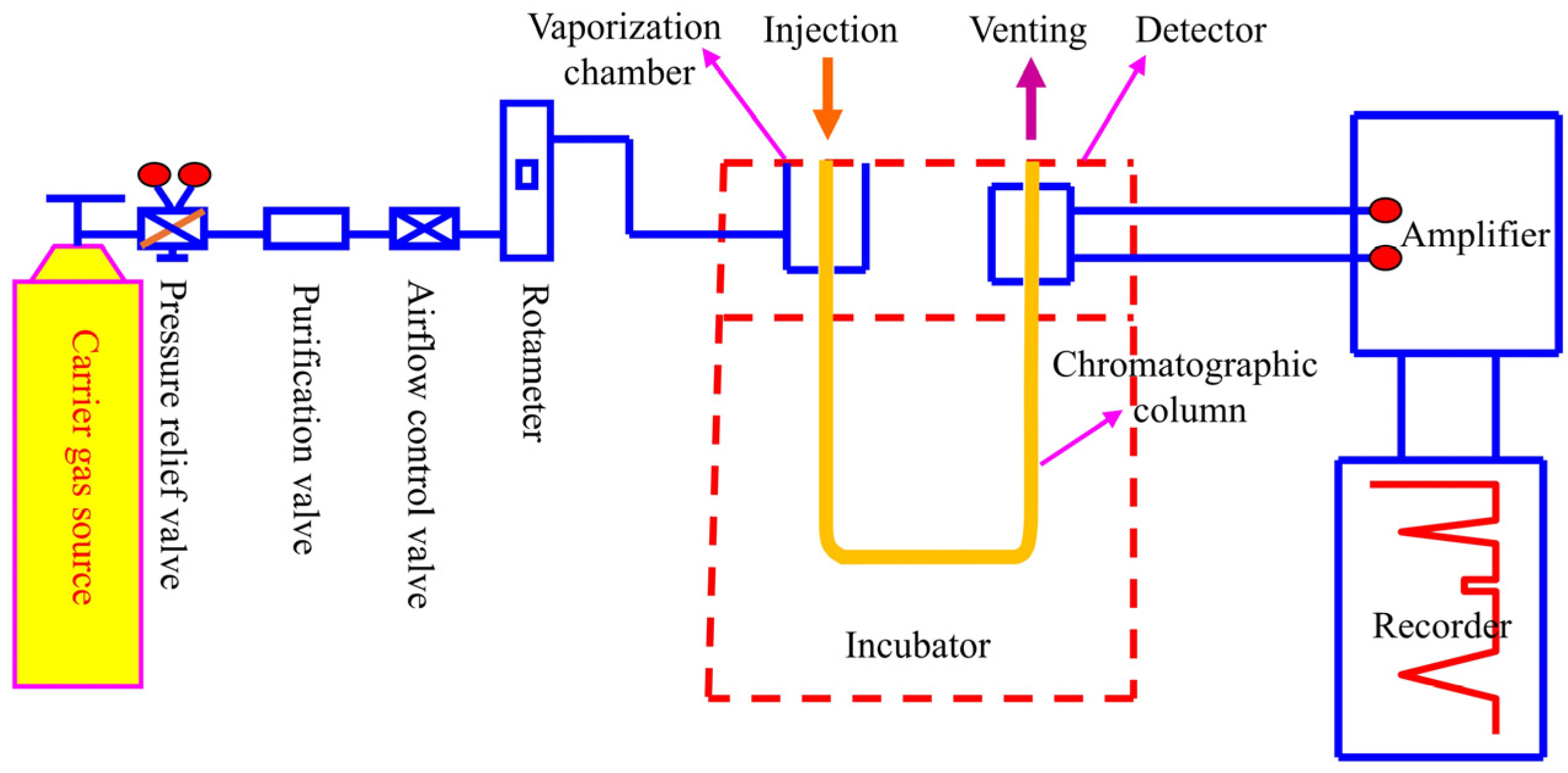
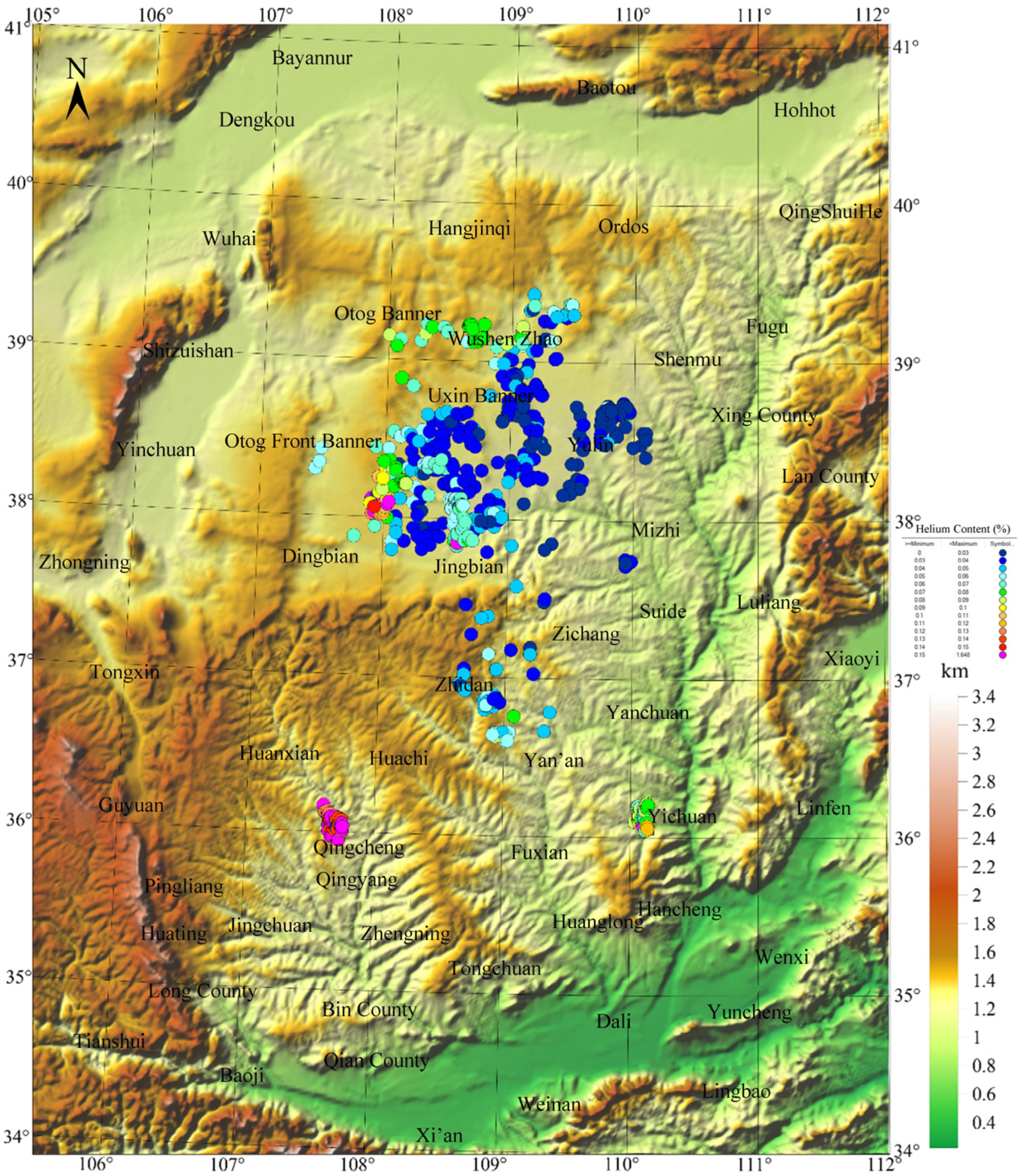
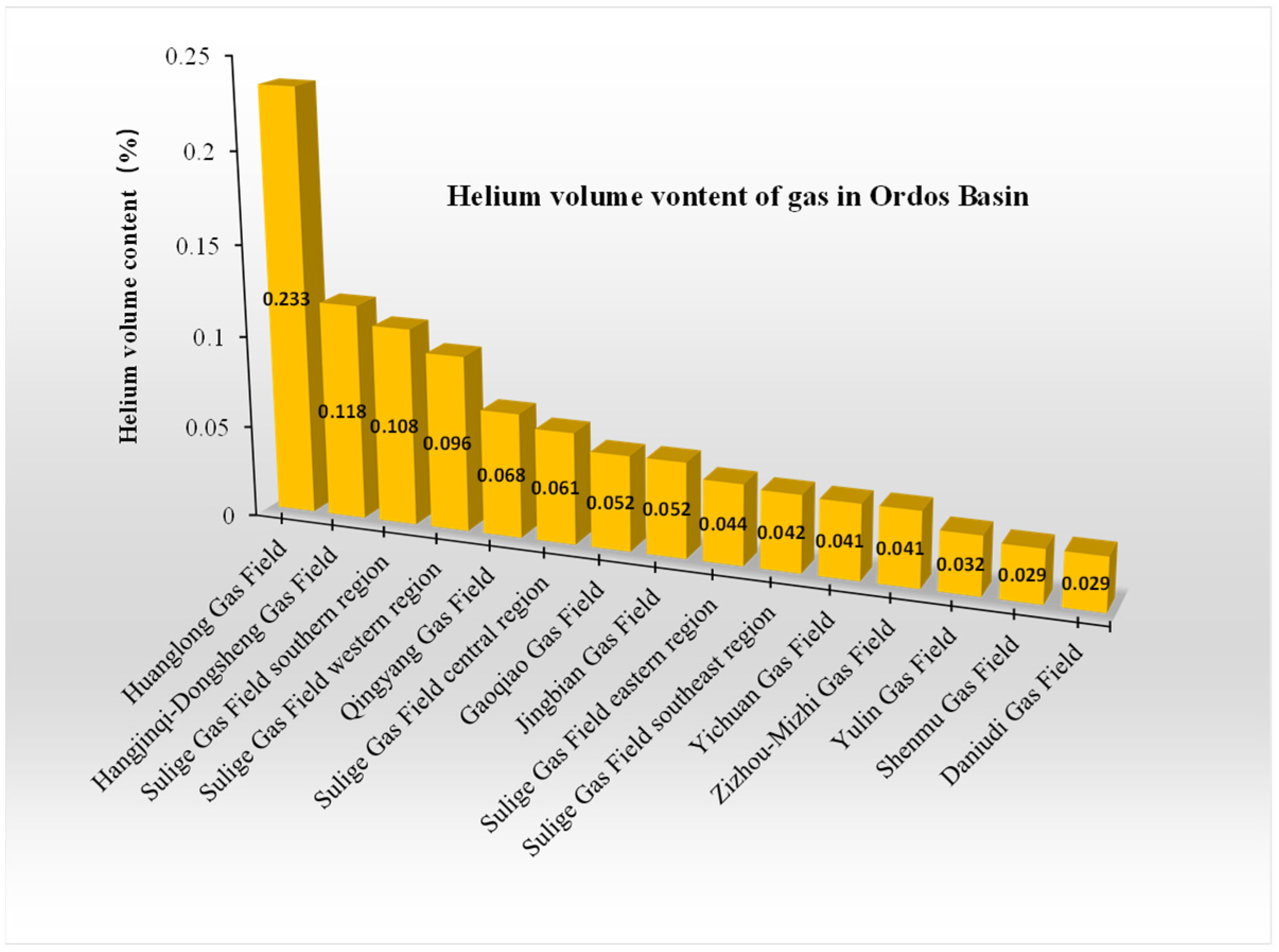



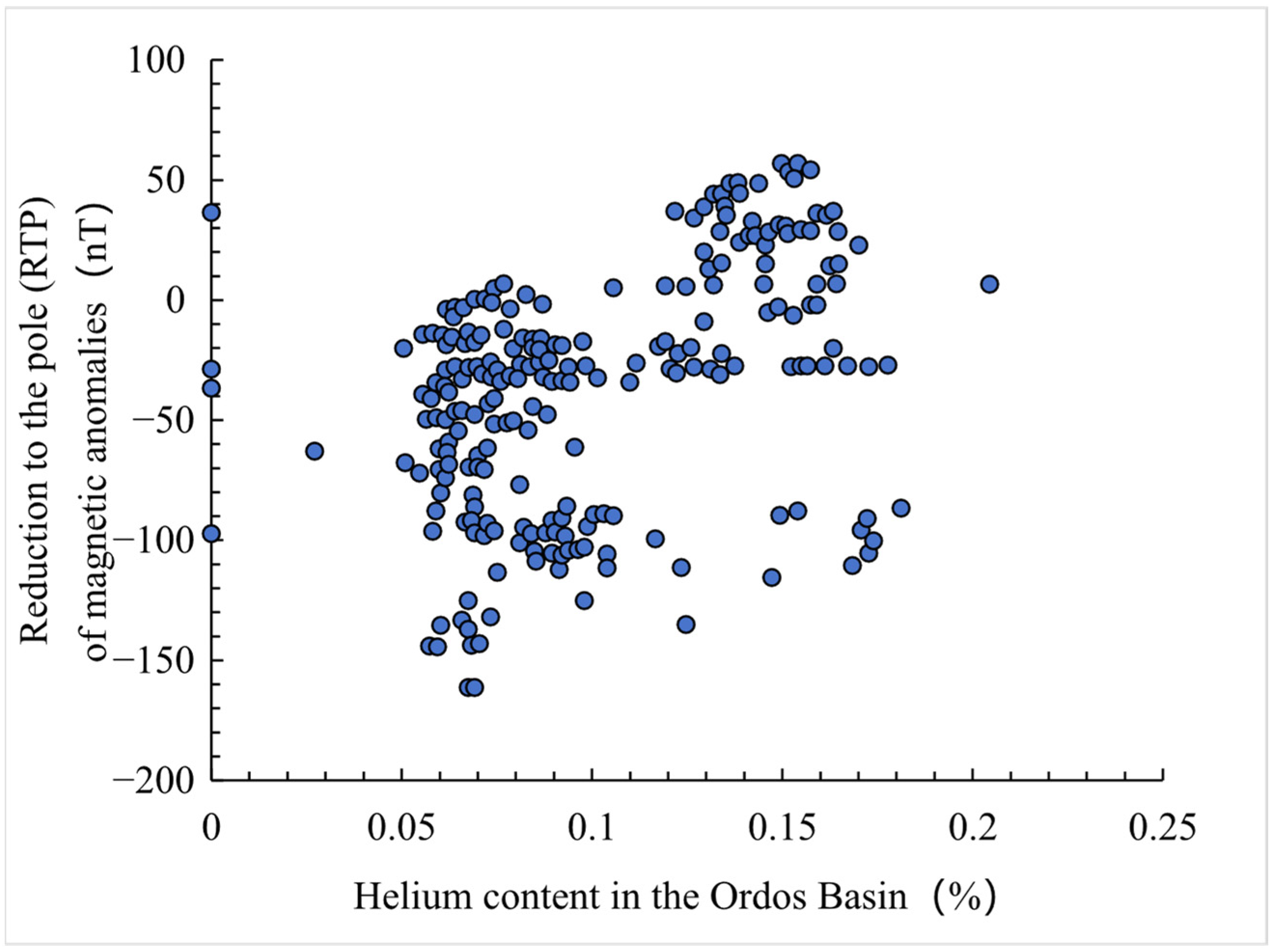


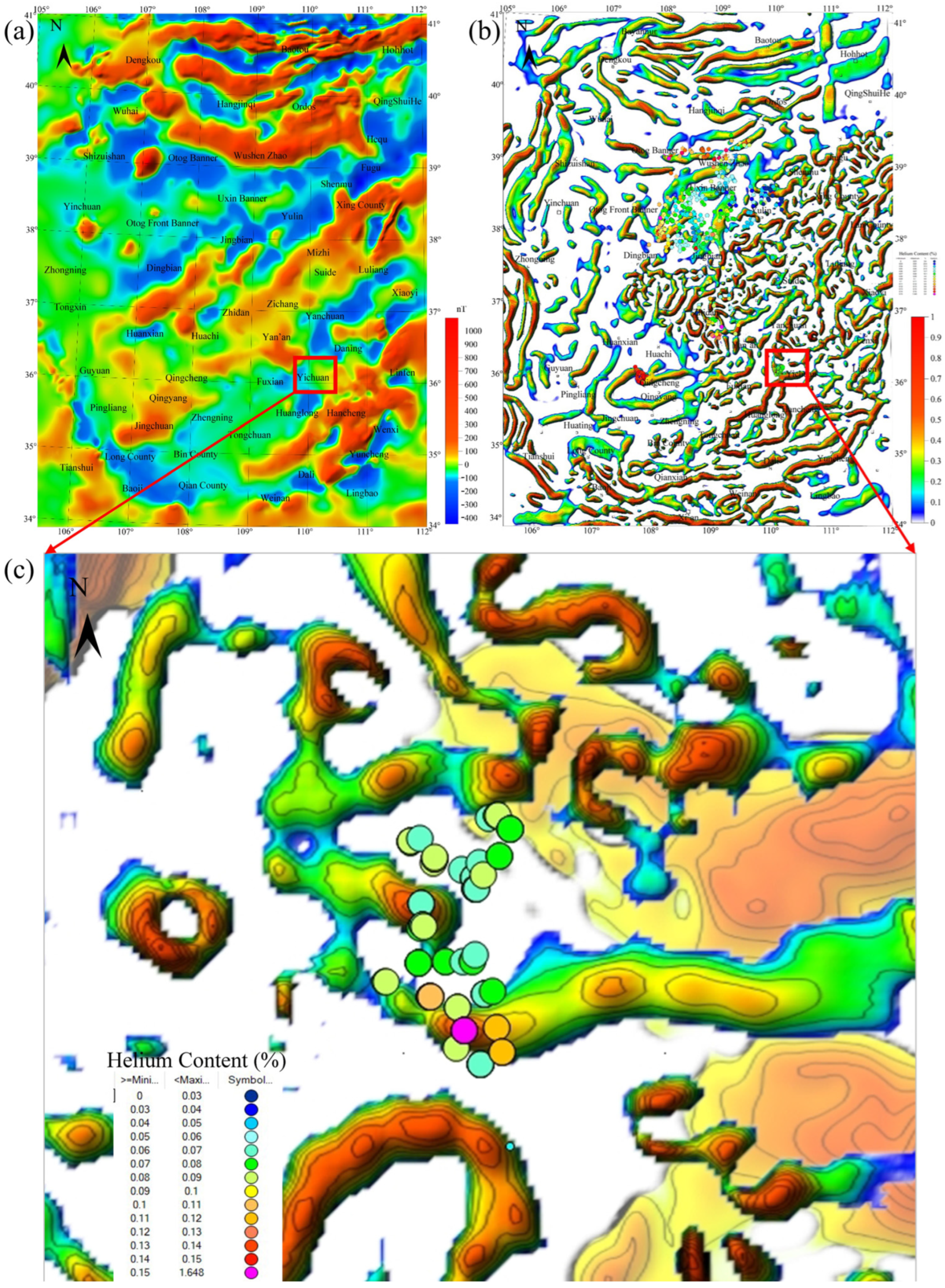
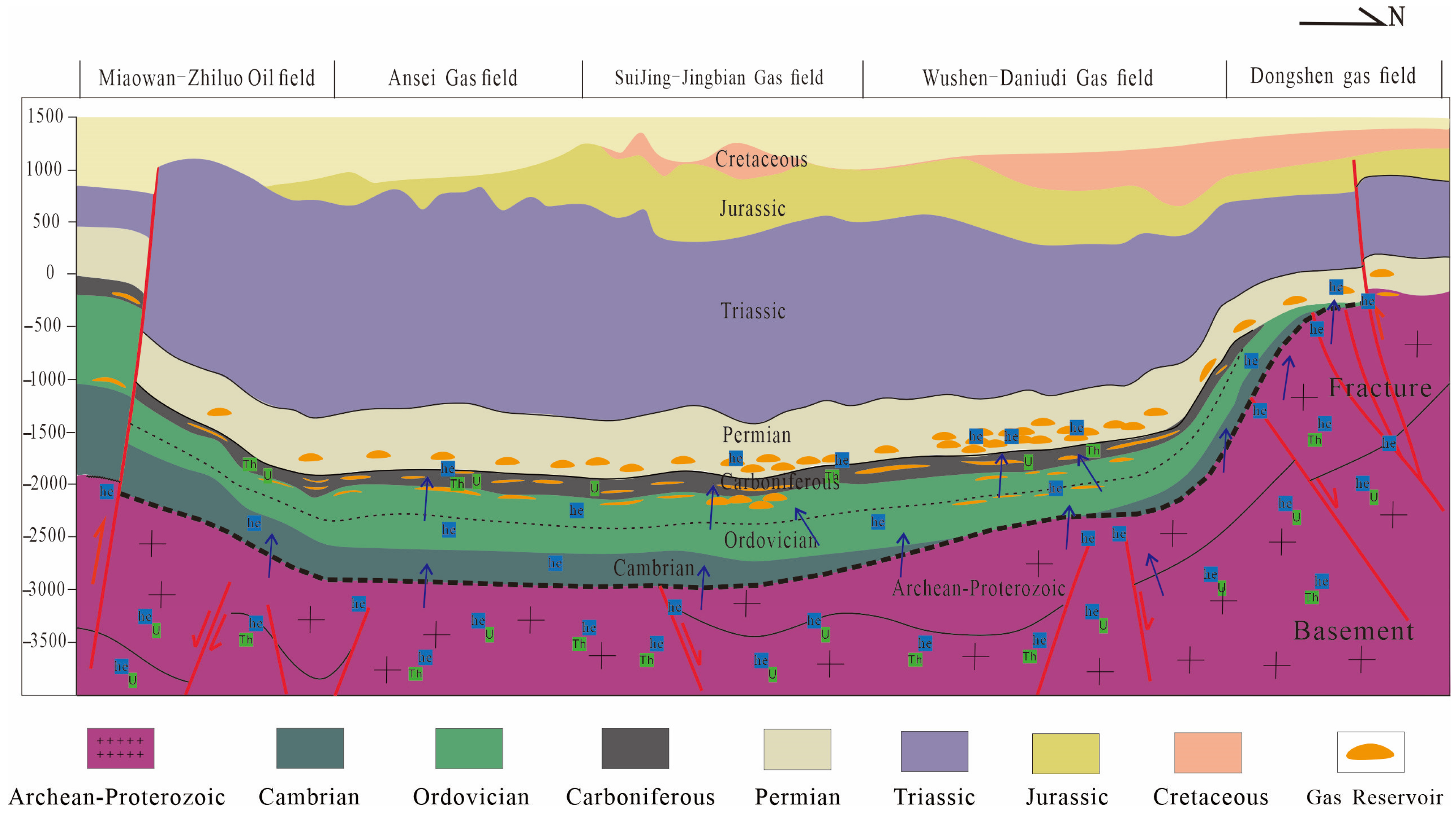
| Well No. | Shaanxi Key Laboratory of Petroleum Accumulation Geology | National Engineering Laboratory for Exploration and Development of Low-Permeability Oil & Gas Fields | Research Institute of Petroleum Exploration & Development |
|---|---|---|---|
| Su B-1 | 0.025 | 0.02 | |
| Su B-2 | 0.033 | 0.03 | |
| Jing A-1 | 0.033 | 0.03 | |
| Su C | 0.033 | 0.03 | |
| Jing A-2 | 0.034 | 0.03 | |
| Su B-3 | 0.041 | 0.04 | |
| Su B-4 | 0.034 | 0.03 | |
| Shuang A | 0.018 | 0.02 | |
| Jing A-3 | 0.04 | 0.04 | |
| Zhao A | 0.043 | 0.04 |
| Rock Type | Distribution Pattern of U and Th | Occurrence Forms of U and Th | U- and Th-Rich Rock Types | Helium Release Characteristics |
|---|---|---|---|---|
| Sedimentary rocks | Primary U and Th contents increase with higher organic matter and clay mineral content. | Mainly adsorbed/complexed by organic matter and clay minerals. | Black shales and bauxite rocks. | Helium’s high porosity and strong solubility in formation water hinder its release, allowing helium produced in source rocks and reservoirs to accumulate efficiently. |
| Magmatic rocks | Acidic rocks have the highest U and Th contents, while mafic rocks have the lowest; late-crystallized portions contain more U and Th than early-crystallized ones. | Mainly enriched in silicate and phosphate minerals via isomorphism. | Granite. | Low porosity and weak helium solubility. Tectonic uplift and fracturing lead to large-scale helium releases. |
| Metamorphic rocks | Content depends on protolith U/Th content and metamorphic grade; high-grade metamorphism mobilizes U and Th. | Multiple occurrence forms coexist; mobilized U and Th entering fluids. | Lightly metamorphosed rocks derived from U- and Th-rich protoliths. | Porosity is higher than granite, with moderate formation water solubility for helium, which makes helium relatively difficult to release. |
| Nuclide | Half-Life | Daughter | Yield (Atoms/Decay) | Comments |
|---|---|---|---|---|
| 3H | 12.26 | 3He | 1 | Continuously produced in atm |
| 238U | 4.468 Ga | 4He | 8 | Spontaneous fission |
| 136Xe | 3.6 × 10−8 | |||
| (4.4 ± 0.1) × 10−8 | ||||
| 235U | 0.7038 Ga | 4He | 7 | 238U/235U = 137.88 |
| 232Th | 14.01 Ga | 4He | 6 | Th/U = 3.8 in bulk Earth |
| 136Xe | <4.2 × 10−11 | No significant production in Earth | ||
| 40K | 1.251 Ga | 40Ar | 0.1048 | 40K = 0.01167% total K |
| 244Pu | 80.0 Ma | 136Xe | 7.00 × 10−5 | 244Pu/238U = 6.8 × 10−3 at 4.56 Ga |
| 129I | 15.7 Ma | 129Xe | 1 | 129I/127I = 1.1 × 10−4 at 4.56 Ga |
| Era | Stratum/Rock Mass | Magnetic Susceptibility/(10−5) | |
|---|---|---|---|
| Range | Average | ||
| Cenozoic | Quaternary system | 36~79 | 56 |
| Paleogene and Neogene | 5~13 | 9.6 | |
| Mesozoic | Cretaceous system | 10.5~58.9 | 18.6 |
| Jurassic system | 6.5~17.3 | 10.5 | |
| Triassic system | 8.8~18.6 | 15.3 | |
| Paleozoic erathem | Permian system | 2.5~22.0 | 16.3 |
| Carboniferous system | 3.2~20.8 | 9.6 | |
| Ordovician system | 5.6~14.6 | 8.8 | |
| Cambrian system | 10.5~16.8 | 12.7 | |
| Proterozoic | 5.4~9.2 | 7.8 | |
| Archean | Granulite | 1300~10,600 | 5600 |
| Gneiss | 8.6~1400 | 780 | |
| Migmatite | 10.5~16.8 | 13.6 | |
| Marble | 11.6~245 | 18.4 | |
| Diorite | 40~9545 | 5332 | |
Disclaimer/Publisher’s Note: The statements, opinions and data contained in all publications are solely those of the individual author(s) and contributor(s) and not of MDPI and/or the editor(s). MDPI and/or the editor(s) disclaim responsibility for any injury to people or property resulting from any ideas, methods, instructions or products referred to in the content. |
© 2025 by the authors. Licensee MDPI, Basel, Switzerland. This article is an open access article distributed under the terms and conditions of the Creative Commons Attribution (CC BY) license (https://creativecommons.org/licenses/by/4.0/).
Share and Cite
Wang, D.; Ma, L.; Zhang, T.; Zhu, D.; Jin, X.; Wang, G.; Peng, J. Distribution Patterns and Main Controlling Factors of Helium in the Ordos Basin. Appl. Sci. 2025, 15, 8806. https://doi.org/10.3390/app15168806
Wang D, Ma L, Zhang T, Zhu D, Jin X, Wang G, Peng J. Distribution Patterns and Main Controlling Factors of Helium in the Ordos Basin. Applied Sciences. 2025; 15(16):8806. https://doi.org/10.3390/app15168806
Chicago/Turabian StyleWang, Dahai, Lichi Ma, Tao Zhang, Dongya Zhu, Xiaohui Jin, Guojun Wang, and Jun Peng. 2025. "Distribution Patterns and Main Controlling Factors of Helium in the Ordos Basin" Applied Sciences 15, no. 16: 8806. https://doi.org/10.3390/app15168806
APA StyleWang, D., Ma, L., Zhang, T., Zhu, D., Jin, X., Wang, G., & Peng, J. (2025). Distribution Patterns and Main Controlling Factors of Helium in the Ordos Basin. Applied Sciences, 15(16), 8806. https://doi.org/10.3390/app15168806







